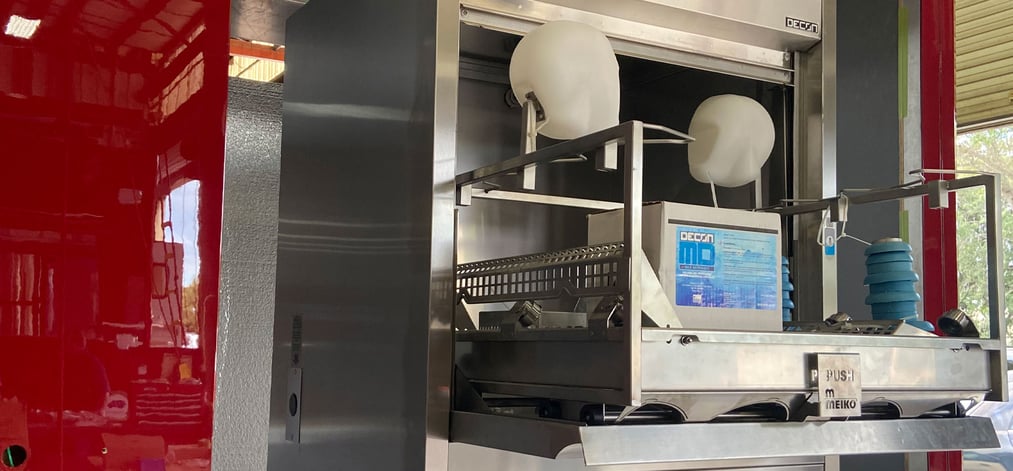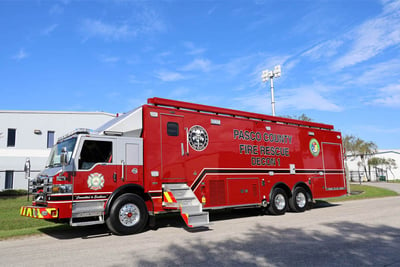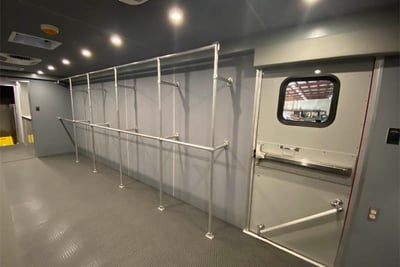
Mobile decontamination units are emerging as part of health and safety best practices to protect firefighters and other emergency response personnel from dangerous toxins on turnout gear, self-contained breathing apparatus (SCBA), helmets, gloves, boots, and other equipment.
Bringing decontamination systems to the scene of a fire is a preventative approach to reduce exposure to carcinogens and other toxic materials.
Continue reading to learn more about decontamination trucks and their benefits to the firefighting industry.
What Is A Mobile Decontamination Unit?
A mobile decontamination unit is a vehicle designed to clean soiled personal protective equipment (PPE) at an emergency scene, minimizing the time that first responders are exposed to toxins and hazardous chemicals.
With a focus on speed and effectiveness in decontaminating people and equipment, mobile decon units are designed specifically to match the mission of the local community. In many areas, the unit travels with other emergency response vehicles to ensure quick access to decontamination systems.
Why is There a Need for Mobile Decontamination Systems?
 A single fire may ignite wood, building materials, electronics, furniture, apparel, metals, and plastics, releasing hundreds of potentially harmful toxins and gasses into the surrounding environment. It’s no surprise to learn that cancer from exposure to these toxins is one of the most dangerous threats to health and safety firefighters face.
A single fire may ignite wood, building materials, electronics, furniture, apparel, metals, and plastics, releasing hundreds of potentially harmful toxins and gasses into the surrounding environment. It’s no surprise to learn that cancer from exposure to these toxins is one of the most dangerous threats to health and safety firefighters face.
- Cancer caused 66 percent of career firefighter line-of-duty deaths from 2002 to 2019, according to data from the International Association of Fire Fighters (IAFF).
- According to a National Institute for Occupational Safety and Health (NIOSH) study, firefighters have a 9 percent higher risk of being diagnosed with cancer and a 14 percent higher risk of dying from cancer than the general U.S. population.
The development of mobile decontamination units and systems is a result of a paradigm shift in the best practices that protect the health and safety of first responders.
A mobile decontamination vehicle is a preventative evolution of safety practices focused on addressing dangerous toxins at the scene.
Every time a first responder is required to don an SCBA, hazardous toxins in the air collect on equipment and protective apparel. The International Association of Fire Fighters explains this idea further in its whitepaper, “Exposures to Carcinogens" where it states the following:
“In a 2020 research study that evaluated chemicals in the air and on firefighter ensembles, researchers identified that gloves are some of the most contaminated. Some gloves had high contaminant levels and were generally more contaminated than turnout coats. The study identified that routine gross decontamination appeared to reduce many of the contaminants. This highlights the importance of on-scene gross decontamination of PPE and equipment, hand washing and showering within the hour of returning to the station.”
Fires and Emergency Response Events Are Inherently Hazardous
Mobile decontamination units adopt a hazmat approach to safety, focusing on three critical elements: time, distance, and shielding.
- Firefighters spend less time in soiled gear.
- Firefighters distance themselves from contaminated gear by rinsing down to remove surface toxins, removing and decontaminating equipment promptly, and changing into clean gear prior to entering the fire truck cab.
- Other first responders are shielded from contamination exposure by cleaning equipment promptly on scene, and by storing contaminated bunker gear outside of the cab.
Addressing carcinogen exposure early and often is the best prevention method to promote long-term health and safety for firefighters.
How Do Decontamination Vehicles Support Communities?
First responders are a valuable part of our community. Not only do they support the safety and wellness of citizens, but first responders are family, neighbors, and friends. The increasing focus on eliminating time spent in soiled PPE benefits the firefighters and their families directly.
In addition to supporting the brave women and men in service, there are added psychological benefits for family members and the community at large, knowing that firefighters' health is a top priority.
Firefighters put their lives on the line for their community, and the increasing focus on their on-site protection is just one step toward providing ongoing support for their health and wellness.
Design Features of Mobile Decontamination Units
 Mobile decontamination units are designed to provide rapid and efficient decontamination services at an emergency scene but each department, station or agency approaches decontamination in a different way.
Mobile decontamination units are designed to provide rapid and efficient decontamination services at an emergency scene but each department, station or agency approaches decontamination in a different way.
Here are some of the features you may choose to include on your custom mobile decontamination unit.
- Separate entry and exit doors
- Walk through bays with ramps for easy accessibility
- Changing rooms or resting rooms
- Storage areas for clean tools and equipment (attire, sanitizing tools and equipment, additional privacy tents, etc.)
- Storage areas for soiled PPE
- Shower, soap and sanitation plumbing (interior or exterior)
- Wastewater storage area
- Heating and/or cooling systems
- Fume exhaust vents
- Lead and asbestos filtration systems
Choosing what to include on board a mobile decontamination unit is based on the types of missions the specialty vehicle will support. Working with your custom mobile decontamination unit manufacturer to understand the best type of truck, storage, and equipment required to meet the needs of the local community is the best place to start.
Why Choose Frontline Communications?
Frontline Communications has been leading the industry in designing and developing highly customized communication vehicles, including broadcast vehicles, command vehicles, and specialty vehicles. With a dynamic and agile approach to design and manufacturing, Frontline Communications works with customers to understand their unique vehicle needs and builds custom products to exceed their expectations.
What decontamination features would support the emergencies you respond to? Let us know how we can help support your department’s needs.
